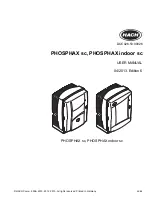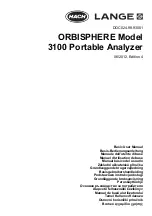
8
3 Specifications of sun[e]
3.1 Specifications of sun[e]
sun[e] measures the solar radiation received by a plane surface from a 180
o
field of view angle. This
quantity, expressed in W/m
2
, is called “hemispherical” solar radiation. sun[e] offers irradiance in W/m
2
as a digital output. It must be used in combination with suitable power supply and a data acquisition
system which uses the Modbus communication protocol over an RS-485 connection. When operated
with both heater and ventilator [ON] or both [OFF], or with only the ventilator [ON] the instrument is
classified as secondary standard according to ISO 9060. It should be used in accordance with the
recommended practices of ISO, IEC, WMO and ASTM.
Table 3.1.1
Specifications of sun[e] (continued on next pages)
sun[e] MEASUREMENT SPECIFICATIONS:
ISO classification (ISO 9060:1990)
secondary standard pyranometer
WMO performance level (WMO-No. 8,
seventh edition 2008)
high quality pyranometer
Response time (95 %)
3 s
Zero offset a (response to 200 W/m
2
net
thermal radiation)
- in standard operating mode
- in medium power mode
- in low power mode
2 W/m
2
2 W/m
2
5 W/m
2
Zero offset b (response to 5 K/h change in
ambient temperature)
< 2 W/m
2
Non-stability
< 0.5 % change per year
Non-linearity
< 0.2 % (100 to 1000 W/m
2
)
Directional response
< 10 W/m
2
Directional response test of individual
instrument
report included
Spectral selectivity
< 3 % (0.35 to 1.5 x 10
-6
m)
Temperature response
< 0.4 % (-30 to +50 °C)
Temperature response test of individual
instrument
report included
Tilt response
< 0.2 % (0 to 90 ° at 1000 W/m
2
)
Measurement range
-400 to 4000 W/m
2
Zero offset steady state
< 1 W/m
2
(-40 to + 80 °C)
Spectral range
(20 % transmission points)
285 to 3000 x 10
-9
m
Figure 3.1.1
Spectral response of the pyranometer compared to the solar spectrum. The
pyranometer only cuts off a negligible part of the total solar spectrum.

![Предварительный просмотр 1 страницы Lambrecht sun[e] 00.16130.501030 Manual](http://thumbs.mh-extra.com/thumbs/lambrecht/sun-e-00-16130-501030/sun-e-00-16130-501030_manual_671567-01.webp)
![Предварительный просмотр 2 страницы Lambrecht sun[e] 00.16130.501030 Manual](http://thumbs.mh-extra.com/thumbs/lambrecht/sun-e-00-16130-501030/sun-e-00-16130-501030_manual_671567-02.webp)
![Предварительный просмотр 3 страницы Lambrecht sun[e] 00.16130.501030 Manual](http://thumbs.mh-extra.com/thumbs/lambrecht/sun-e-00-16130-501030/sun-e-00-16130-501030_manual_671567-03.webp)
![Предварительный просмотр 4 страницы Lambrecht sun[e] 00.16130.501030 Manual](http://thumbs.mh-extra.com/thumbs/lambrecht/sun-e-00-16130-501030/sun-e-00-16130-501030_manual_671567-04.webp)
![Предварительный просмотр 5 страницы Lambrecht sun[e] 00.16130.501030 Manual](http://thumbs.mh-extra.com/thumbs/lambrecht/sun-e-00-16130-501030/sun-e-00-16130-501030_manual_671567-05.webp)
![Предварительный просмотр 6 страницы Lambrecht sun[e] 00.16130.501030 Manual](http://thumbs.mh-extra.com/thumbs/lambrecht/sun-e-00-16130-501030/sun-e-00-16130-501030_manual_671567-06.webp)
![Предварительный просмотр 7 страницы Lambrecht sun[e] 00.16130.501030 Manual](http://thumbs.mh-extra.com/thumbs/lambrecht/sun-e-00-16130-501030/sun-e-00-16130-501030_manual_671567-07.webp)
![Предварительный просмотр 8 страницы Lambrecht sun[e] 00.16130.501030 Manual](http://thumbs.mh-extra.com/thumbs/lambrecht/sun-e-00-16130-501030/sun-e-00-16130-501030_manual_671567-08.webp)
![Предварительный просмотр 9 страницы Lambrecht sun[e] 00.16130.501030 Manual](http://thumbs.mh-extra.com/thumbs/lambrecht/sun-e-00-16130-501030/sun-e-00-16130-501030_manual_671567-09.webp)
![Предварительный просмотр 10 страницы Lambrecht sun[e] 00.16130.501030 Manual](http://thumbs.mh-extra.com/thumbs/lambrecht/sun-e-00-16130-501030/sun-e-00-16130-501030_manual_671567-10.webp)
![Предварительный просмотр 11 страницы Lambrecht sun[e] 00.16130.501030 Manual](http://thumbs.mh-extra.com/thumbs/lambrecht/sun-e-00-16130-501030/sun-e-00-16130-501030_manual_671567-11.webp)
![Предварительный просмотр 12 страницы Lambrecht sun[e] 00.16130.501030 Manual](http://thumbs.mh-extra.com/thumbs/lambrecht/sun-e-00-16130-501030/sun-e-00-16130-501030_manual_671567-12.webp)
![Предварительный просмотр 13 страницы Lambrecht sun[e] 00.16130.501030 Manual](http://thumbs.mh-extra.com/thumbs/lambrecht/sun-e-00-16130-501030/sun-e-00-16130-501030_manual_671567-13.webp)
![Предварительный просмотр 14 страницы Lambrecht sun[e] 00.16130.501030 Manual](http://thumbs.mh-extra.com/thumbs/lambrecht/sun-e-00-16130-501030/sun-e-00-16130-501030_manual_671567-14.webp)
![Предварительный просмотр 15 страницы Lambrecht sun[e] 00.16130.501030 Manual](http://thumbs.mh-extra.com/thumbs/lambrecht/sun-e-00-16130-501030/sun-e-00-16130-501030_manual_671567-15.webp)
![Предварительный просмотр 16 страницы Lambrecht sun[e] 00.16130.501030 Manual](http://thumbs.mh-extra.com/thumbs/lambrecht/sun-e-00-16130-501030/sun-e-00-16130-501030_manual_671567-16.webp)
![Предварительный просмотр 17 страницы Lambrecht sun[e] 00.16130.501030 Manual](http://thumbs.mh-extra.com/thumbs/lambrecht/sun-e-00-16130-501030/sun-e-00-16130-501030_manual_671567-17.webp)
![Предварительный просмотр 18 страницы Lambrecht sun[e] 00.16130.501030 Manual](http://thumbs.mh-extra.com/thumbs/lambrecht/sun-e-00-16130-501030/sun-e-00-16130-501030_manual_671567-18.webp)
![Предварительный просмотр 19 страницы Lambrecht sun[e] 00.16130.501030 Manual](http://thumbs.mh-extra.com/thumbs/lambrecht/sun-e-00-16130-501030/sun-e-00-16130-501030_manual_671567-19.webp)
![Предварительный просмотр 20 страницы Lambrecht sun[e] 00.16130.501030 Manual](http://thumbs.mh-extra.com/thumbs/lambrecht/sun-e-00-16130-501030/sun-e-00-16130-501030_manual_671567-20.webp)
![Предварительный просмотр 21 страницы Lambrecht sun[e] 00.16130.501030 Manual](http://thumbs.mh-extra.com/thumbs/lambrecht/sun-e-00-16130-501030/sun-e-00-16130-501030_manual_671567-21.webp)
![Предварительный просмотр 22 страницы Lambrecht sun[e] 00.16130.501030 Manual](http://thumbs.mh-extra.com/thumbs/lambrecht/sun-e-00-16130-501030/sun-e-00-16130-501030_manual_671567-22.webp)
![Предварительный просмотр 23 страницы Lambrecht sun[e] 00.16130.501030 Manual](http://thumbs.mh-extra.com/thumbs/lambrecht/sun-e-00-16130-501030/sun-e-00-16130-501030_manual_671567-23.webp)

















